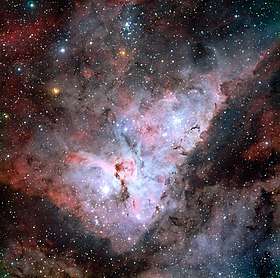BO Carinae
BO Carinae, also known as HD 93420, is an irregular variable star in the constellation Carina.
| Observation data Epoch J2000 Equinox J2000 | |
|---|---|
| Constellation | Carina |
| Right ascension | 10h 46m 00.53s |
| Declination | 59° 29′ 19.5″ |
| Apparent magnitude (V) | 7.18 - 8.50[1] |
| Characteristics | |
| Spectral type | M4 Ib[1] |
| Variable type | Lc[1] |
| Astrometry | |
| Proper motion (μ) | RA: −7.080±0.133[2] mas/yr Dec.: −1.750±0.141[2] mas/yr |
| Parallax (π) | 0.73 ± 0.08[2] mas |
| Distance | 2,500 ly (8,150[3][4] pc) |
| Absolute magnitude (MV) | −5.53[5] |
| Details | |
| Radius | 439[6] R☉ |
| Luminosity | 26,000 - 27,000[6] L☉ |
| Temperature | 3,535±170[6] K |
| Other designations | |
BO Car, Trumpler 16, IDS 10419-5858, IRAS 10438-5913, 2MASS J10455065-5929193, AAVSO 1042-58, SAO 238447, CD-58 3547, HD 93420 | |
| Database references | |
| SIMBAD | data |
BO Car has a maximum apparent magnitude of +7.18. Its distance and membership is uncertain, but its possible membership to the star cluster Trumpler 15 allows a distance estimate of approximately 2,500 parsecs (8,150 light-years).[3][4]
BO Car is a red supergiant of spectral type M4Ib with an effective temperature of 3,525 K, a radius of 439 solar radii. Its bolometric luminosity is 26,000 L☉.[5] Mass-loss is on the order of 0.3 × 10−9 solar masses per year.[4]
Billed as an irregular variable like TZ Cassiopeiae or V528 Carinae; its apparent brightness fluctuates between magnitude +7.18 and +8.50 without periodicity.[1]
References
- Samus, N. N.; Durlevich, O. V.; et al. (2009). "VizieR Online Data Catalog: General Catalogue of Variable Stars (Samus+ 2007-2013)". VizieR On-line Data Catalog: B/GCVS. Originally Published in: 2009yCat....102025S. 1. Bibcode:2009yCat....102025S.
- Brown, A. G. A.; et al. (Gaia collaboration) (August 2018). "Gaia Data Release 2: Summary of the contents and survey properties". Astronomy & Astrophysics. 616. A1. arXiv:1804.09365. Bibcode:2018A&A...616A...1G. doi:10.1051/0004-6361/201833051. Gaia DR2 record for this source at VizieR.
- Tapia, Mauricio; Roth, Miguel; Vázquez, Rubén A.; Feinstein, Alejandro (2003). "Imaging study of NGC 3372, the Carina nebula - I. UBVRIJHK photometry of Tr 14, Tr 15, Tr 16 and Car I". Monthly Notices of the Royal Astronomical Society. 339 (1): 44–62. Bibcode:2003MNRAS.339...44T. doi:10.1046/j.1365-8711.2003.06186.x.
- Josselin, E.; Blommaert, J. A. D. L.; Groenewegen, M. A. T.; Omont, A.; Li, F. L. (2000). "Observational investigation of mass loss of M supergiants". Astronomy and Astrophysics. 357: 225–232. Bibcode:2000A&A...357..225J.
- Levesque, Emily M.; Massey, Philip; Olsen, K. A. G.; Plez, Bertrand; Josselin, Eric; Maeder, Andre; Meynet, Georges (August 2005). "The Effective Temperature Scale of Galactic Red Supergiants: Cool, but Not As Cool As We Thought". The Astrophysical Journal. 628 (2): 973–985. arXiv:astro-ph/0504337. Bibcode:2005ApJ...628..973L. doi:10.1086/430901.
- Messineo, M.; Brown, A. G. A. (2019). "A Catalog of Known Galactic K-M Stars of Class I Candidate Red Supergiants in Gaia DR2". The Astronomical Journal. 158 (1): 20. arXiv:1905.03744. Bibcode:2019AJ....158...20M. doi:10.3847/1538-3881/ab1cbd.
This article is issued from Wikipedia. The text is licensed under Creative Commons - Attribution - Sharealike. Additional terms may apply for the media files.
